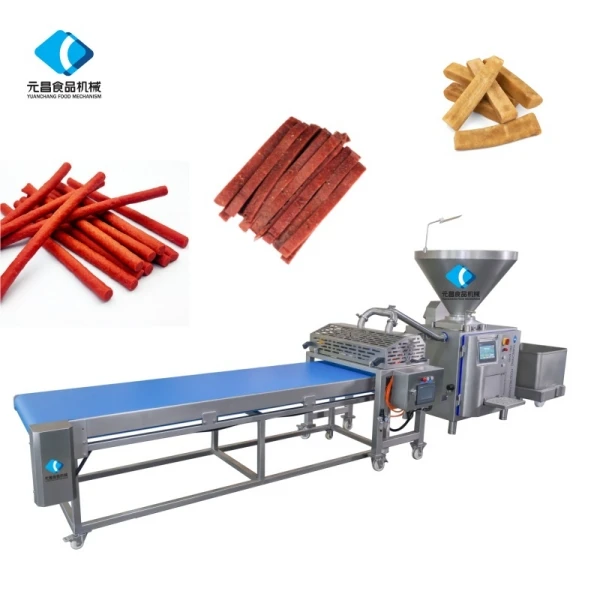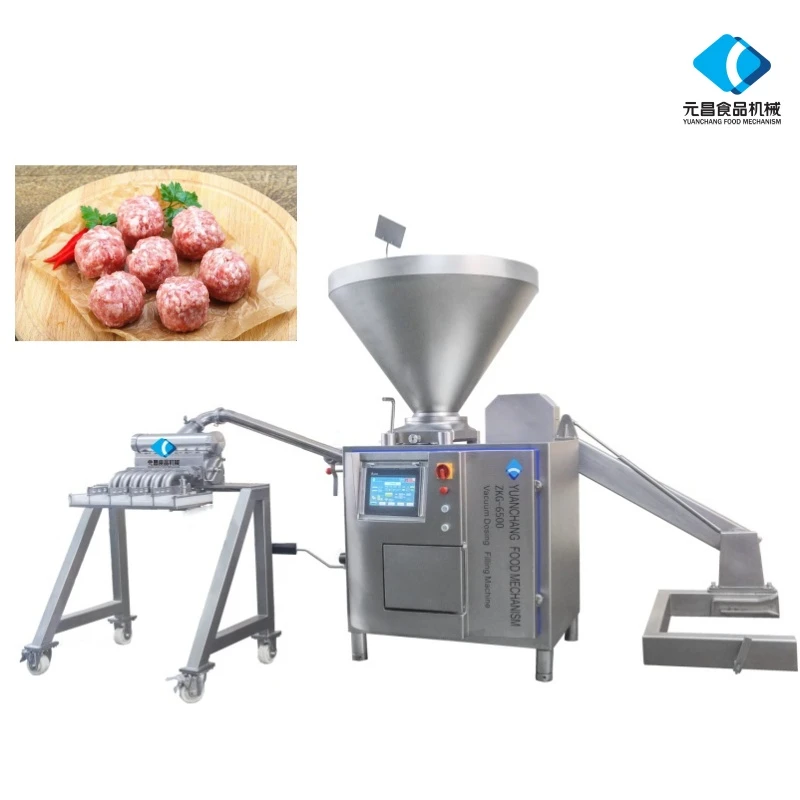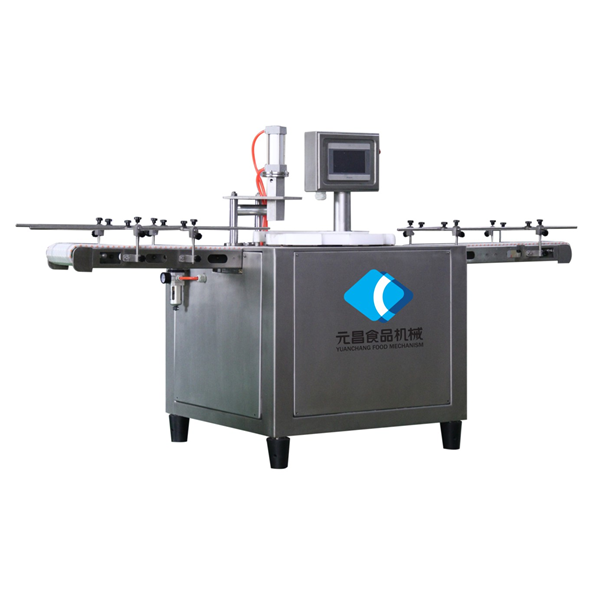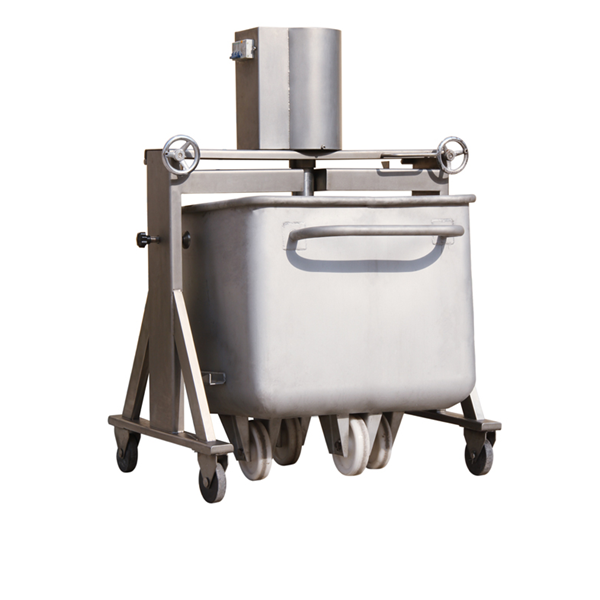High-Performance Meat Vacuum Mixer for Superior Product Quality
Driving Efficiency and Quality with Advanced Meat Vacuum Mixing Technology
In the highly competitive food processing industry, achieving superior product quality, consistency, and extended shelf life is paramount. Central to these objectives is the critical process of mixing and tumbling, especially for meat products. The meat vacuum mixer stands as an indispensable piece of equipment, revolutionizing how meat processors enhance flavor absorption, protein extraction, and overall product texture. This technology ensures optimal ingredient distribution while minimizing air inclusion, a common detriment to product quality and shelf stability.
This comprehensive guide delves into the nuances of vacuum mixing technology, offering B2B decision-makers and technical engineers a detailed overview of its design, operational advantages, and strategic implementation within modern food production lines.
Industry Trends and Market Dynamics in Meat Processing
The global meat processing industry is undergoing significant transformation, driven by consumer demand for healthier, more natural, and convenience-oriented products. Key trends influencing equipment choices, particularly for a meat vacuum mixer, include:
- Demand for Clean Label Products: A growing preference for products with fewer artificial additives necessitates efficient mixing techniques to maximize the efficacy of natural ingredients and marinades. Vacuum technology aids in deeper penetration, reducing the need for excessive chemical enhancers.
- Automation and Digitalization: The integration of IoT and AI into processing equipment leads to smarter, more efficient operations. Modern vacuum meat mixer systems often feature programmable logic controllers (PLCs) and touch-screen interfaces for precise control and data logging.
- Sustainability and Resource Efficiency: Energy consumption, water usage, and waste reduction are critical. Advanced mixers are designed for energy efficiency and easy cleaning, contributing to sustainable operations.
- Food Safety and Traceability: Strict regulatory environments (e.g., FDA, USDA, HACCP) mandate robust food safety protocols. Equipment designed with hygienic principles, such as easy-to-clean surfaces and minimal crevices, is highly valued.
According to a report by MarketsandMarkets, the global meat processing equipment market is projected to reach USD 16.5 billion by 2027, growing at a CAGR of 6.2%. Vacuum mixers are a significant segment within this growth, driven by their ability to meet stringent quality and efficiency requirements.
The Manufacturing Process of a High-Performance Meat Vacuum Mixer
The production of a robust and hygienic meat tumbler mixer involves a multi-stage process, ensuring durability, precision, and adherence to food safety standards. The primary materials used are high-grade stainless steel, typically SUS304 or SUS316L, known for their corrosion resistance and ease of sanitation.
Key Manufacturing Stages:
- Material Selection & Preparation: Food-grade stainless steel sheets (e.g., 304/316L) are selected based on design specifications. These materials undergo strict quality checks for composition and surface finish.
- Precision Cutting & Forming: CNC laser cutting and plasma cutting technologies are employed for precise shaping of the mixing drum, frame, and internal components. Advanced bending and rolling machines form the drum and vacuum chamber with minimal stress points.
- Welding & Assembly: Skilled technicians perform TIG (Tungsten Inert Gas) welding for critical components, ensuring smooth, crevice-free joints to prevent bacterial growth and facilitate cleaning. Robotic welding may be used for consistency in larger batches. The internal paddles or baffles are meticulously positioned for optimal tumbling action.
- Surface Treatment & Polishing: All contact surfaces are polished to a mirror finish (e.g., Ra < 0.8 µm) to enhance hygiene, reduce product adhesion, and improve corrosion resistance. This is crucial for FDA and USDA compliance.
- Component Integration: High-quality, food-grade motors, vacuum pumps, control systems (PLCs, HMI), and sealing mechanisms are integrated. Electrical wiring adheres to international standards (e.g., IEC, UL).
- Rigorous Testing & Quality Assurance: Each meat vacuum mixer undergoes extensive testing. This includes vacuum integrity checks, functional testing of all mechanical and electrical components, noise level assessments, and trial runs with simulated loads. Equipment typically complies with international standards such as ISO 9001 (Quality Management), ISO 14001 (Environmental Management), and specific food safety directives like HACCP and CE marking for European markets. The expected service life, with proper maintenance, exceeds 15 years, demonstrating robust engineering and material quality.
Target industries benefiting from this precise manufacturing include large-scale meat processing plants, poultry processors, seafood processing facilities, and ready-meal production lines, where advantages like energy saving through optimized mixing cycles and superior corrosion resistance are critical for long-term operational efficiency.
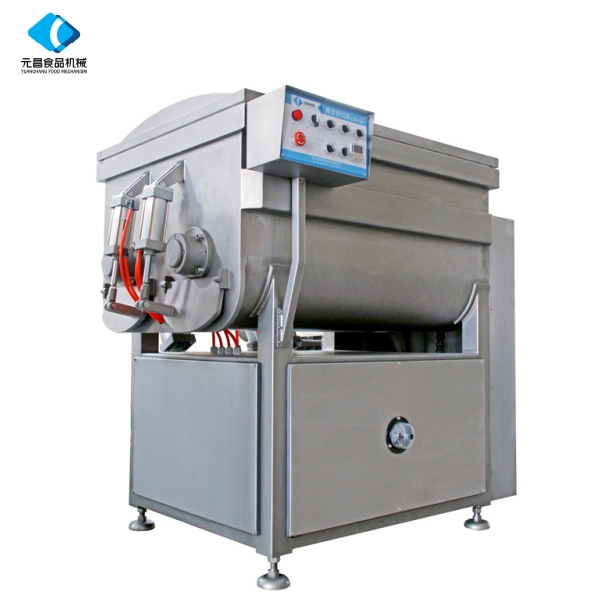
Technical Specifications and Parameters
A thorough understanding of technical specifications is essential for selecting the appropriate vacuum meat mixer. These parameters directly influence performance, throughput, and product quality. Below is a representative table of key specifications:
Typical Meat Vacuum Mixer Specifications
| Parameter | Range/Description |
|---|---|
| Capacity (Liters) | 100 L to 5000 L (scalable) |
| Mixing Speed (RPM) | Variable, typically 5-20 RPM |
| Vacuum Pressure (MPa) | -0.08 to -0.09 MPa (adjustable) |
| Material Construction | Food-grade SUS304 / SUS316L Stainless Steel |
| Motor Power (kW) | 5.5 kW to 37 kW (depending on capacity) |
| Control System | PLC with HMI Touch Screen |
| Temperature Control | Optional cooling jacket for precise temperature management |
| Hygiene Standards | HACCP compliant, USDA/FDA guidelines |
Understanding these specifications allows processors to match equipment capabilities with their specific product requirements and production volumes, ensuring optimal investment.
Key Technical Advantages of Vacuum Mixing
The distinct advantages offered by a meat vacuum mixer go beyond simple mixing, impacting product quality, shelf life, and operational efficiency significantly.
- Enhanced Protein Extraction: The vacuum environment facilitates the opening of meat fibers, allowing for better protein extraction. This is crucial for developing natural binders in emulsified products like sausages, leading to better texture and reduced cook loss.
- Superior Marinade Penetration and Flavor Uniformity: Under vacuum, air is removed from the meat, creating a spongy texture. When the vacuum is released, the marinade is drawn deeply and evenly into the meat structure, resulting in consistent flavor distribution and improved yield. This is a critical advantage for products requiring deep marination.
- Extended Shelf Life: By removing oxygen during mixing, the vacuum process significantly inhibits bacterial growth and oxidative spoilage. This naturally extends the product's shelf life without relying heavily on artificial preservatives.
- Improved Product Texture and Tenderness: The gentle tumbling action combined with vacuum conditions prevents product damage and ensures a tender, juicy final product. This is particularly beneficial for whole muscle products or delicate meat cuts.
- Reduced Processing Time: The efficiency of vacuum marination often reduces the required mixing time compared to atmospheric tumbling, leading to higher throughput and energy savings. A typical reduction in processing time can range from 20-40%.
- Consistent Product Quality: Automated vacuum systems with precise control over vacuum levels, mixing speed, and duration ensure repeatable results batch after batch, leading to unparalleled product consistency.

Application Scenarios Across the Meat Industry
The versatility of the meat vacuum mixer makes it invaluable across a wide spectrum of meat processing applications.
- Processed Meats (Sausages, Ham, Bacon): Essential for protein extraction and even distribution of cure ingredients, resulting in optimal texture, binding, and color development.
- Marinated Poultry and Seafood: Significantly reduces marination time and ensures deep, uniform flavor penetration for products like chicken breasts, wings, fish fillets, and shrimp. This also helps in improving tenderness and juiciness.
- Ready Meals and Deli Meats: Used for pre-mixing ingredients, incorporating spices, and ensuring consistent texture in products destined for further processing or direct consumption.
- Vegetarian and Vegan Protein Products: Increasingly utilized for plant-based meat alternatives to achieve desired textures, bind ingredients, and evenly distribute flavorings in a controlled environment.
- Pet Food Production: Ensures thorough mixing of various ingredients, including meat, vegetables, and binders, leading to consistent quality in pet food formulations.
In each scenario, the controlled environment of a vacuum meat mixer enhances product quality, extends freshness, and optimizes resource utilization, proving its indispensability in modern food production lines.

Vendor Comparison and Selection Criteria
Choosing the right supplier for a meat vacuum mixer requires careful consideration of various factors beyond just the initial purchase price. Leading manufacturers differentiate themselves through innovation, service, and adherence to quality.
Key Comparison Factors:
- Reputation & Experience: Look for vendors with a proven track record (e.g., 20+ years in the industry) and positive customer testimonials. Certifications like ISO 9001 and CE are strong indicators of reliability.
- Technology & Innovation: Assess the control system (PLC brand, HMI features), vacuum pump efficiency, and unique mixing paddle designs. Does the vendor offer options like integrated cooling jackets or automated loading/unloading?
- Material Quality & Hygiene: Verify the grade of stainless steel used (e.g., SUS304 for food contact, SUS316L for corrosive environments). Ensure smooth welds, polished surfaces, and ease of cleaning to meet HACCP standards.
- Customization Capabilities: Can the vendor tailor the mixer capacity, drum design, or control system to specific production requirements? This is crucial for optimizing workflows.
- After-Sales Support: Evaluate warranty terms, availability of spare parts, technical support, and local service options. A strong global service network is a significant advantage.
Comparison Table: Leading Vacuum Mixer Features (Illustrative)
| Feature | Vendor A (e.g., YCMEATMECH) | Vendor B | Vendor C |
|---|---|---|---|
| Material (Food Contact) | SUS304/316L | SUS304 | SUS304 |
| Control System | Siemens PLC, HMI | Basic PLC, push buttons | Allen-Bradley PLC, HMI |
| Vacuum Pump | High-efficiency, oil-lubricated | Standard, oil-less option | Water ring vacuum pump |
| Cooling Jacket | Optional, efficient | Not available | Optional, standard |
| Automatic Loading/Unloading | Fully integrated | Manual/Semi-auto | Integrated option |
| Certifications | CE, ISO 9001, HACCP | CE | CE, ISO 9001 |
This comparative approach assists buyers in identifying the best-fit solution that aligns with their production scale, budget, and long-term quality objectives.
Customized Solutions for Unique Production Needs
Recognizing that no two food processing operations are identical, leading manufacturers of vacuum meat mixer equipment offer extensive customization options. These tailored solutions ensure seamless integration into existing production lines and optimization for specific product types or operational constraints.
Customization Areas Include:
- Capacity & Size: From laboratory-scale units (e.g., 50-liter) to industrial giants (e.g., 5000-liter), mixers can be built to match exact throughput requirements.
- Drum Design & Mixing Paddles: Specialized drum shapes or paddle configurations can be designed for delicate products, high-viscosity mixes, or specific tumbling actions (e.g., for whole muscles vs. ground meat).
- Automated Loading & Unloading Systems: Integration with hoists, conveyor belts, or automatic discharge chutes for continuous processing lines.
- Temperature Control: Double-jacketed drums for heating or cooling, ensuring precise temperature management during mixing, critical for certain enzymatic processes or preventing bacterial growth.
- Control System Enhancements: Advanced PLC programming for complex mixing cycles, recipe management, data logging for HACCP compliance, and remote monitoring capabilities.
- Material Grade Selection: Option for SUS316L stainless steel for highly corrosive environments or specialized cleaning agents.
Engaging with a vendor offering robust engineering and design capabilities ensures a customized meat tumbler mixer that perfectly integrates into your workflow, maximizing return on investment and operational efficiency.

Application Case Studies & Customer Successes
Real-world applications vividly demonstrate the transformative impact of a high-quality vacuum meat mixer.
Case Study 1: Large-Scale Poultry Processor
A leading poultry processing plant faced challenges with inconsistent marinade absorption and high drip loss in their marinated chicken breast products. After integrating a 1500L YCMEATMECH meat vacuum mixer, they observed:
- 30% reduction in marination time.
- 15% increase in final product yield due to improved moisture retention.
- Significantly more uniform flavor distribution, leading to a 25% increase in positive customer feedback.
- Extended shelf life by 3 days due to reduced oxygen exposure.
"The vacuum mixer transformed our marinated product line. The consistency and efficiency gains were immediate and substantial." - Production Manager, Global Poultry Group.
Case Study 2: Artisan Sausage Manufacturer
An artisan sausage producer struggled to achieve the desired texture and protein binding in their traditional sausage recipes without excessive additives. Implementing a 500L vacuum meat mixer allowed them to:
- Achieve superior protein extraction, resulting in a firmer, more desirable bite.
- Reduce cooking loss by 10%, improving yield and reducing waste.
- Maintain a clean label product by enhancing natural binding properties.
- Increase production capacity by streamlining the mixing process.
These instances underscore the practical value and return on investment offered by advanced vacuum mixing technology.
Frequently Asked Questions (FAQ)
Q1: What are the primary benefits of a vacuum meat mixer over a standard mixer?
A1: The main benefits include enhanced marinade penetration, improved protein extraction, extended product shelf life due to oxygen removal, superior texture and tenderness, and reduced processing times. A standard mixer cannot achieve these advantages as it operates at atmospheric pressure, allowing air inclusion.
Q2: What maintenance is required for a meat vacuum mixer?
A2: Regular maintenance includes daily cleaning and sanitization, routine inspection of seals and gaskets, lubrication of moving parts, and periodic checks of the vacuum pump and electrical components. Adhering to the manufacturer's maintenance schedule ensures longevity and optimal performance.
Q3: Can a vacuum meat mixer handle different types of meat products?
A3: Yes, modern meat vacuum mixer systems are highly versatile. With adjustable mixing speeds, vacuum levels, and customizable paddle designs, they can efficiently process a wide range of products from delicate whole muscle cuts and marinated poultry to ground meats for sausages and plant-based protein alternatives.
Q4: What is the typical lead time for a new meat vacuum mixer?
A4: Lead times can vary based on customization and current production schedules. For standard models, lead time typically ranges from 8-12 weeks. Customized or large-capacity units may require 12-20 weeks. Specific lead times will be provided upon quotation.
Lead Time, Warranty, and After-Sales Support
Lead Time & Fulfillment:
Our streamlined manufacturing process and efficient supply chain enable us to provide competitive lead times. Standard models of the vacuum meat mixer are typically shipped within 8-12 weeks from order confirmation. For highly customized solutions, a detailed project timeline will be provided during the consultation phase, usually extending to 12-20 weeks depending on complexity. We prioritize transparent communication regarding production milestones and delivery schedules.
Warranty Commitments:
Every YCMEATMECH meat vacuum mixer comes with a comprehensive 12-month warranty on parts and manufacturing defects, starting from the date of installation or 18 months from shipment, whichever comes first. This warranty covers all major components, including the motor, vacuum pump, and control system, provided the equipment has been operated and maintained according to our guidelines. Extended warranty options are available upon request.
Customer Support & After-Sales Service:
Our commitment extends far beyond the sale. We offer robust after-sales support designed to ensure continuous, trouble-free operation of your equipment:
- Technical Assistance: Our team of expert engineers provides remote technical support via phone, email, and video conferencing to diagnose and resolve issues promptly.
- On-Site Support: For complex issues or preventative maintenance, our field service technicians are available for on-site visits globally.
- Spare Parts Availability: We maintain a comprehensive inventory of genuine spare parts to minimize downtime. Critical components are typically shipped within 24-48 hours.
- Training: We provide detailed operational and maintenance training for your staff during installation and offer refresher courses as needed.
Our goal is to be a reliable partner, ensuring the long-term success and efficiency of your meat processing operations.
References
- Food and Drug Administration (FDA). (2023). Current Good Manufacturing Practice (CGMP) Regulations for Food and Dietary Supplements. www.fda.gov
- United States Department of Agriculture (USDA). (2022). Food Safety and Inspection Service (FSIS) Directives. www.fsis.usda.gov
- International Organization for Standardization (ISO). (2021). ISO 9001: Quality Management Systems – Requirements. www.iso.org
- MarketsandMarkets. (2022). Meat Processing Equipment Market - Global Forecast to 2027. www.marketsandmarkets.com
- Codex Alimentarius Commission. (2020). General Principles of Food Hygiene (CXC 1-1969). www.fao.org/fao-who-codexalimentarius
-
Meat Portioning Machine: Precision, Efficiency & Sustainability in Meat ProcessingNewsNov.24,2025
-
Discover the Benefits of Vacuum Marinating Machines for Efficient Food ProcessingNewsNov.24,2025
-
The Ultimate Guide to Commercial Chicken Scalders: Efficiency, Sustainability & InnovationNewsNov.23,2025
-
Chicken Harvesting Equipment: Efficient & Humane Solutions for Poultry ProducersNewsNov.22,2025
-
Comprehensive Guide to Meat Processing Plant Equipment | Efficiency, Safety & SustainabilityNewsNov.21,2025
-
Meat Processing Bins: Durable Solutions for Safe & Efficient Meat Handling WorldwideNewsNov.20,2025





